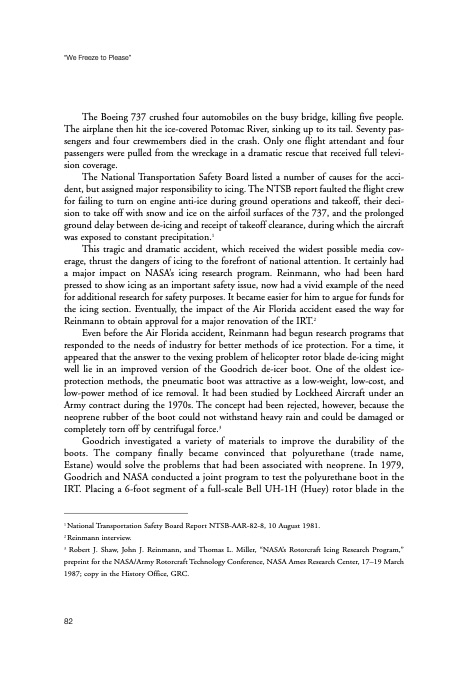
PDF Publication Title:
Text from PDF Page: 094
“We Freeze to Please” The Boeing 737 crushed four automobiles on the busy bridge, killing five people. The airplane then hit the ice-covered Potomac River, sinking up to its tail. Seventy pas- sengers and four crewmembers died in the crash. Only one flight attendant and four passengers were pulled from the wreckage in a dramatic rescue that received full televi- sion coverage. The National Transportation Safety Board listed a number of causes for the acci- dent, but assigned major responsibility to icing. The NTSB report faulted the flight crew for failing to turn on engine anti-ice during ground operations and takeoff, their deci- sion to take off with snow and ice on the airfoil surfaces of the 737, and the prolonged ground delay between de-icing and receipt of takeoff clearance, during which the aircraft was exposed to constant precipitation.1 This tragic and dramatic accident, which received the widest possible media cov- erage, thrust the dangers of icing to the forefront of national attention. It certainly had a major impact on NASA’s icing research program. Reinmann, who had been hard pressed to show icing as an important safety issue, now had a vivid example of the need for additional research for safety purposes. It became easier for him to argue for funds for the icing section. Eventually, the impact of the Air Florida accident eased the way for Reinmann to obtain approval for a major renovation of the IRT.2 Even before the Air Florida accident, Reinmann had begun research programs that responded to the needs of industry for better methods of ice protection. For a time, it appeared that the answer to the vexing problem of helicopter rotor blade de-icing might well lie in an improved version of the Goodrich de-icer boot. One of the oldest ice- protection methods, the pneumatic boot was attractive as a low-weight, low-cost, and low-power method of ice removal. It had been studied by Lockheed Aircraft under an Army contract during the 1970s. The concept had been rejected, however, because the neoprene rubber of the boot could not withstand heavy rain and could be damaged or completely torn off by centrifugal force.3 Goodrich investigated a variety of materials to improve the durability of the boots. The company finally became convinced that polyurethane (trade name, Estane) would solve the problems that had been associated with neoprene. In 1979, Goodrich and NASA conducted a joint program to test the polyurethane boot in the IRT. Placing a 6-foot segment of a full-scale Bell UH-1H (Huey) rotor blade in the 1 National Transportation Safety Board Report NTSB-AAR-82-8, 10 August 1981. 2 Reinmann interview. 3 Robert J. Shaw, John J. Reinmann, and Thomas L. Miller, “NASA’s Rotorcraft Icing Research Program,” preprint for the NASA/Army Rotorcraft Technology Conference, NASA Ames Research Center, 17–19 March 1987; copy in the History Office, GRC. 82PDF Image | History of NASA Icing Research Tunnel

PDF Search Title:
History of NASA Icing Research TunnelOriginal File Name Searched:
sp4226.pdfDIY PDF Search: Google It | Yahoo | Bing
NFT (Non Fungible Token): Buy our tech, design, development or system NFT and become part of our tech NFT network... More Info
IT XR Project Redstone NFT Available for Sale: NFT for high tech turbine design with one part 3D printed counter-rotating energy turbine. Be part of the future with this NFT. Can be bought and sold but only one design NFT exists. Royalties go to the developer (Infinity) to keep enhancing design and applications... More Info
Infinity Turbine IT XR Project Redstone Design: NFT for sale... NFT for high tech turbine design with one part 3D printed counter-rotating energy turbine. Includes all rights to this turbine design, including license for Fluid Handling Block I and II for the turbine assembly and housing. The NFT includes the blueprints (cad/cam), revenue streams, and all future development of the IT XR Project Redstone... More Info
Infinity Turbine ROT Radial Outflow Turbine 24 Design and Worldwide Rights: NFT for sale... NFT for the ROT 24 energy turbine. Be part of the future with this NFT. This design can be bought and sold but only one design NFT exists. You may manufacture the unit, or get the revenues from its sale from Infinity Turbine. Royalties go to the developer (Infinity) to keep enhancing design and applications... More Info
Infinity Supercritical CO2 10 Liter Extractor Design and Worldwide Rights: The Infinity Supercritical 10L CO2 extractor is for botanical oil extraction, which is rich in terpenes and can produce shelf ready full spectrum oil. With over 5 years of development, this industry leader mature extractor machine has been sold since 2015 and is part of many profitable businesses. The process can also be used for electrowinning, e-waste recycling, and lithium battery recycling, gold mining electronic wastes, precious metals. CO2 can also be used in a reverse fuel cell with nafion to make a gas-to-liquids fuel, such as methanol, ethanol and butanol or ethylene. Supercritical CO2 has also been used for treating nafion to make it more effective catalyst. This NFT is for the purchase of worldwide rights which includes the design. More Info
NFT (Non Fungible Token): Buy our tech, design, development or system NFT and become part of our tech NFT network... More Info
Infinity Turbine Products: Special for this month, any plans are $10,000 for complete Cad/Cam blueprints. License is for one build. Try before you buy a production license. May pay by Bitcoin or other Crypto. Products Page... More Info
| CONTACT TEL: 608-238-6001 Email: greg@infinityturbine.com | RSS | AMP |